 W
WA granitoid or granitic rock is a variety of coarse grained plutonic rock — granite or similar — which mineralogically is composed predominantly of feldspar, quartz and mica. Examples of granitoid rocks include granite, quartz monzonite, quartz diorite, syenite, granodiorite, tonalite and trondhjemite. Many are created by continental volcanic arc subduction or the collision of sialic masses. Volcanic rocks are common with granitoids and typically have the same origins. However, they are normally worn away after years of erosion.
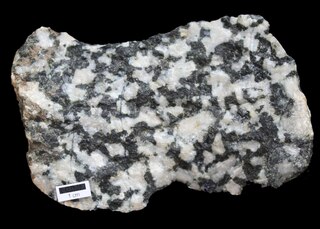 W
WDiorite is an intrusive igneous rock composed principally of the silicate minerals plagioclase feldspar, biotite, hornblende, and/or pyroxene. The chemical composition of diorite is intermediate, between that of mafic gabbro and felsic granite. Diorite is usually grey to dark grey in colour, but it can also be black or bluish-grey, and frequently has a greenish cast. It is distinguished from gabbro on the basis of the composition of the plagioclase species; the plagioclase in diorite is richer in sodium and poorer in calcium. Diorite may contain small amounts of quartz, microcline, and olivine. Zircon, apatite, titanite, magnetite, ilmenite, and sulfides occur as accessory minerals. Minor amounts of muscovite may also be present. Varieties deficient in hornblende and other dark minerals are called leucodiorite. When olivine and more iron-rich augite are present, the rock grades into ferrodiorite, which is transitional to gabbro. The presence of significant quartz makes the rock type quartz-diorite or tonalite, and if orthoclase is present at greater than 10 percent, the rock type grades into monzodiorite or granodiorite. A dioritic rock containing feldspathoid mineral/s and no quartz is termed foid-bearing diorite or foid diorite according to content.
 W
WThe Ellicott City Granodiorite is a Silurian or Ordovician granitic pluton in Howard and Baltimore Counties, Maryland. It is described as a biotite granodiorite along the margin of the intrusion which grades into a quartz monzonite in its core. It intrudes through the Wissahickon Formation and the Baltimore Gabbro Complex.
 W
WGranodiorite is a phaneritic-textured intrusive igneous rock similar to granite, but containing more plagioclase feldspar than orthoclase feldspar. According to the QAPF diagram, granodiorite has a greater than 20% quartz by volume, and between 65% to 90% of the feldspar is plagioclase. A greater amount of plagioclase would designate the rock as tonalite.
 W
WGreen ubatuba is the commercial name of a Brazilian charnockite, although it is often sold as a granite. It comes from the Ubatuba area of Brazil, where it forms part of the Neoproterozoic Ribeira Belt. As its name indicates, it is green in color, dark green and almost a black appearance when seen in low light. It contains large (10 cm) phenocrysts of alkali feldspar. It is widely used in home renovations and landscaping.
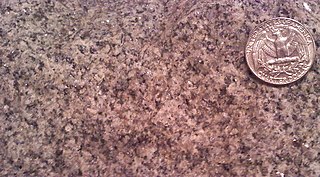 W
WThe Guilford Quartz Monzonite is a Silurian or Ordovician quartz monzonite pluton in Howard County, Maryland. It is described as a biotite-muscovite-quartz monzonite which occurs as discontinuous lenticular bodies which intrude mainly through the Wissahickon Formation (gneiss).
 W
WLeucogranite is a light-colored, granitic, igneous rock with almost no dark minerals. Alaskite is a synonym.
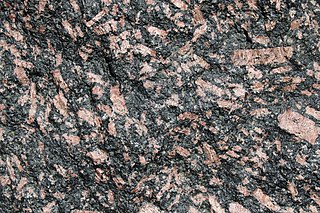 W
WLuxullianite is a rare type of granite, notable for the presence of clusters of radially-arranged acicular tourmaline crystals enclosed by phenocrysts of orthoclase and quartz in a matrix of quartz, tourmaline, alkali feldspar, brown mica, and cassiterite.
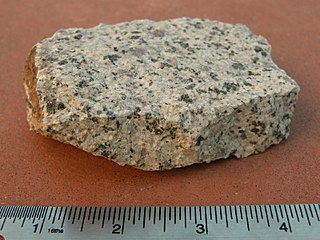 W
WMonzonite is an igneous intrusive rock, formed by slow cooling of underground magma that has a moderate silica content and is enriched in alkali metal oxides. Monzonite is composed mostly of plagioclase and alkali feldspar.
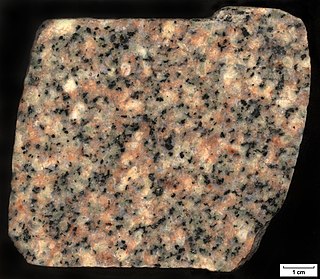 W
WQuartz monzonite or adamellite is an intrusive, felsic, igneous rock that has an approximately equal proportion of orthoclase and plagioclase feldspars. It is typically a light colored phaneritic (coarse-grained) to porphyritic granitic rock. The plagioclase is typically intermediate to sodic in composition, andesine to oligoclase. Quartz is present in significant amounts. Biotite and/or hornblende constitute the dark minerals. Because of its coloring, it is often confused with granite, but whereas granite contains more than 20% quartz, quartz monzonite is only 5–20% quartz. Rock with less than five percent quartz is classified as monzonite. A rock with more alkali feldspar is a syenite whereas one with more plagioclase is a quartz diorite. The fine grained volcanic rock equivalent of quartz monzonite is quartz latite.
 W
WSyenite is a coarse-grained intrusive igneous rock with a general composition similar to that of granite, but deficient in quartz, which, if present at all, occurs in relatively small concentrations. Some syenites contain larger proportions of mafic components and smaller amounts of felsic material than most granites; those are classed as being of intermediate composition. The volcanic equivalent of syenite is trachyte.
 W
WTonalite is an igneous, plutonic (intrusive) rock, of felsic composition, with phaneritic texture. Feldspar is present as plagioclase with 10% or less alkali feldspar. Quartz is present as more than 20% of the rock. Amphiboles and pyroxenes are common accessory minerals.
 W
WThe Woodstock Quartz Monzonite is a Silurian or Ordovician quartz monzonite pluton in Baltimore County, Maryland. It is described as a massive biotite-quartz monzonite which intrudes through the Baltimore Gneiss at a single locality surrounding the town of Granite, Maryland.